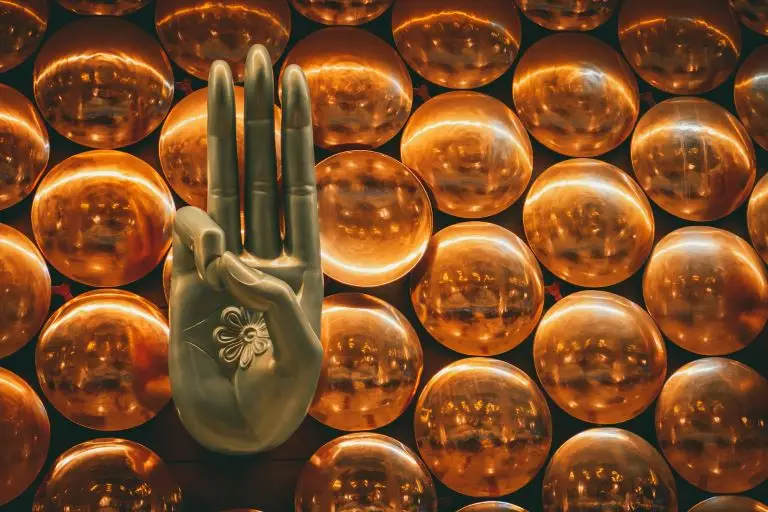There is a rich tradition of Hindus mantras, each with its own unique significance and purpose. Here are five widely recited Hindu mantras along with their meanings.
1. Om (Aum):
This Hindu Mantra is considered the most sacred sound in Hinduism, often described as the sound of the universe. It is a primordial sound, representing the essence of the ultimate reality, Brahman. Chanting “Om” is believed to align the practitioner with the cosmic vibrations and facilitate meditation and spiritual growth. It comprises three sounds: A (ah), U (oo), and M (mm), symbolizing creation, preservation, and dissolution, respectively.
The AUM mantra’s sound is created by the mouth gradually going from fully open to closed during the sounding of AaaaaaaaaUuuuuuuuMmmmmm.
2. Gayatri Mantra:
This Hindu mantra is dedicated to Goddess Gayatri, who is regarded as the Mother of the Vedas and the personification of the divine feminine energy. It’s found in the Rigveda and is considered one of the most powerful mantras for enlightenment and spiritual awakening. The mantra is: “Om Bhur Bhuvah Swaha, Tat Savitur Varenyam, Bhargo Devasya Dheemahi, Dhiyo Yo Nah Prachodayat.” It is a prayer to the divine light to illuminate our intellect and guide us toward righteousness.
3. Om Namah Shivaya:
This mantra is dedicated to Lord Shiva, the destroyer and transformer in the Hindu trinity. It translates to “I bow to Shiva” and is believed to invoke the blessings of Lord Shiva. It’s commonly chanted as a form of worship, devotion, and meditation. Each syllable has symbolic significance: “Om” represents the divine, “Namah” means salutations, and “Shivaya” refers to Shiva.
4. Om Shanti Shanti Shanti:
This mantra is a prayer for peace and is often chanted at the end of Hindu rituals and prayers. The repetition of “Shanti” (peace) three times represents peace at the physical, mental, and spiritual levels. It signifies a desire for inner and outer harmony and is also recited as a universal prayer for world peace.
5. Mahamrityunjaya Mantra:
Also known as the Mrita-Sanjivini mantra, this is a powerful mantra dedicated to Lord Shiva for overcoming fear of death and promoting healing and longevity. The mantra is: “Om Tryambakam Yajamahe, Sugandhim Pushti-Vardhanam, Urvarukamiva Bandhanan, Mrityor Mukshiya Maamritat.” It’s believed to bestow immortality and protect against diseases and untimely death.
These mantras hold deep spiritual significance for Hindus and are chanted for various purposes, including meditation, worship, healing, and seeking divine blessings.
Why are Hindu Mantras chanted 108 times?
Chanting mantras 108 times is a practice rooted in several cultural, spiritual, and philosophical traditions. Here are some of the reasons why this specific number is significant:
- Sacred Number in Hinduism and Buddhism: In Hindu and Buddhist traditions, 108 is considered a sacred number. There are 108 Upanishads, which are the ancient texts of wisdom in Hinduism, and 108 defilements in Buddhism that one must overcome to reach enlightenment.
- Astronomical Significance: The distance between the Earth and the Sun is roughly 108 times the diameter of the Sun. Similarly, the distance between the Earth and the Moon is about 108 times the diameter of the Moon. These relationships are often cited as cosmic reasons for the significance of the number 108.
- Mathematical Properties: The number 108 has many interesting mathematical properties. It is a Harshad number, which means it is an integer divisible by the sum of its digits (1 + 0 + 8 = 9). Such properties can contribute to the mystical and esoteric significance of the number.
- Symbolic Representation: The number 1 represents unity or the higher truth, 0 represents emptiness or completeness in spiritual practice, and 8 represents infinity or eternity. Together, 108 can symbolize the journey towards spiritual completion and unity.
- Mala Beads: In many spiritual practices, mala beads are used for counting recitations of mantras, and a full mala contains 108 beads. This allows practitioners to keep track of their chanting and meditation.
- Vedic Culture: In Vedic cosmology, there are 27 constellations (Nakshatras), each with 4 quarters (Padas), making a total of 108 parts. This structure reflects the comprehensive nature of the cosmos.
- Human Body: In Ayurvedic and yogic traditions, it is believed that there are 108 energy lines (nadis) that converge to form the heart chakra. Therefore, chanting 108 times can be seen as aligning with the body’s subtle energy system.
Chanting Hindu mantras 108 times is therefore a practice imbued with spiritual, cosmic, and cultural significance, aiming to harmonize the mind, body, and spirit with the larger universe.
Learn more about my online Meditation Course.
Why not try a beginner-friendly meditation retreat in the beautiful Devon countryside?
Best Wishes,
David.
© D. R. Durham, All rights reserved, 2024.




